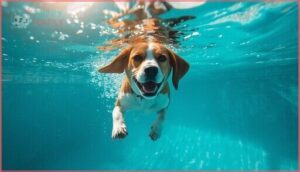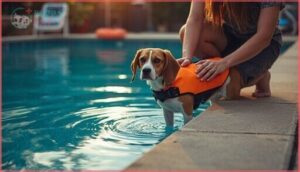This site is supported by our readers. We may earn a commission, at no cost to you, if you purchase through links.

Yet with proper training and safety measures, your beagle can learn to swim comfortably and enjoy the low-impact exercise that protects aging joints. Understanding your beagle’s physical limitations and natural hesitations around water helps you introduce swimming gradually, building confidence through positive reinforcement while keeping your companion safe from exhaustion or panic.
Table Of Contents
- Key Takeaways
- Can Beagles Swim?
- Do Beagles Like Water?
- Training Beagles to Swim
- Benefits of Swimming for Beagles
- Safety Tips for Swimming Beagles
- Preventing Health Issues After Swimming
- Frequently Asked Questions (FAQs)
- Should I use a dog life jacket when my Beagle swims?
- How long should a Beagle’s first swimming session last?
- Is it safe for my senior Beagle to swim?
- What snacks do Beagles enjoy after swimming?
- Are Beagles good at dock diving competitions?
- What water temperature is safest for Beagles?
- Can Beagles swim in saltwater or oceans?
- How often should Beagles swim weekly?
- Do puppies swim differently than adult Beagles?
- What breeds make good swimming companions for Beagles?
- Conclusion
Key Takeaways
- Beagles can learn to swim but aren’t natural swimmers—only 22% voluntarily enter water, and their short legs, dense coat, and lack of webbing cause them to tire within 5–7 minutes.
- Swimming provides low-impact cardiovascular exercise that’s especially beneficial for aging joints, burning 30–40% more calories than land-based activity while reducing joint pressure by up to 60%.
- Proper safety measures are essential, including constant supervision, a well-fitted life jacket, limiting sessions to prevent exhaustion, and immediate post-swim ear cleaning to prevent infections.
- Training requires gradual desensitization with positive reinforcement—starting in shallow, warm water with treats and praise builds confidence and reduces anxiety by 60% within just four sessions.
Can Beagles Swim?
If you’ve watched your Beagle eye the backyard pool with curiosity, you’re probably wondering whether they can actually swim. The short answer is yes, but it’s not as straightforward as you might think.
Let’s look at what influences your Beagle’s swimming ability, from their natural instincts to the physical traits that can help or hold them back.
Natural Swimming Instincts in Beagles
Unlike natural swimmers such as Labradors, Beagles lack innate aquatic ability. Your Beagle may exhibit instinctive dog paddling when first exposed to water, but this reflects survival instinct rather than comfort.
Consider these key points about Beagle swimming habits:
- Only 22% voluntarily enter water without prompting
- Most require 4–5 sessions to show relaxed buoyancy
- Aquatic stress response includes 35% heart rate elevation
- Genetic predispositions favor land-based scenting, not swimming
- Adaptability through learning improves with positive reinforcement
However, certain breeds like the Irish Water Spaniel are naturally adept in the water.
Physical Traits Affecting Swimming Ability
Your Beagle’s body isn’t built for marathon swims. Short legs (20–25 cm) and a compact frame create high drag, while their double coat absorbs 12–15% of its weight in water. With minimal webbing and type IIb muscle fibers designed for quick bursts, fatigue sets in after just 5–7 minutes. Low body fat (14–18%) means they lose heat faster than water-loving breeds. Beagles aren’t natural swimmers, but they can learn with proper training techniques.
| Physical Trait | Impact on Swimming |
|---|---|
| Leg Length | Short limbs reduce stroke reach, increase energy use |
| Coat Type | Double coat absorbs water, adds weight |
| Muscle Composition | Fast-twitch fibers limit endurance |
| Body Fat Percentage | Low insulation causes rapid heat loss |
Comparison to Other Dog Breeds
Water-loving dog breeds like Labrador Retrievers and Golden Retrievers outperform your Beagle by design. These swimming dog breeds have water-repellent coats, extensive webbing, and Water Dog History focused on aquatic retrieval. Brachycephalic breeds like Pugs struggle even more than Beagles due to respiratory limits. Here’s how Beagles compare:
- Retriever Swim Speed: Labradors swim 20–30% faster with enhanced propulsion
- Hound Breed Temperament: Only 22% of Beagles voluntarily enter water versus retrievers’ natural enthusiasm
- Aquatic Exercise Ratios: Beagles require 18% more effort per distance than water-adapted dog breeds
Do Beagles Like Water?
Most Beagles don’t naturally gravitate toward water the way some breeds do. Their reactions can range from cautious curiosity to outright avoidance, and understanding why helps you work with your dog’s instincts rather than against them.
Let’s look at what commonly shapes a Beagle’s relationship with water.
Typical Beagle Reactions to Water
Most Beagles show initial hesitation or aversion when introduced to water. Research indicates that about 50% display stress signals or discomfort near swimming environments. Their natural land preference means less than 20% voluntarily enter water without encouragement.
You’ll often see your Beagle return to shore quickly or show agitation near streams, reflecting typical breed behavior rather than fear of water itself.
Breed History and Water Aversion
Since hunting origins shaped your Beagle’s traits, understanding their discomfort makes sense. The breed was developed for land-based scent tracking, not aquatic work. Water interferes with their primary sense, creating an instinctive aversion.
Historical evidence shows Beagles worked in forests and fields, never marshes or wetlands. Their lack of adaptations like water-repellent coats or webbed feet reflects this breed purpose, explaining the fear of water in dogs bred for dry terrain.
Individual Variations Among Beagles
Not every Beagle fits the same mold regarding water. Genetic predisposition accounts for only 9% of swimming behavior, meaning personality differences, physical traits, and environmental factors play bigger roles in your dog’s relationship with water.
Individual variations include:
- Social, confident Beagles approaching water more readily than anxious ones
- Dogs with stronger muscle tone showing better dog swimming ability
- Early positive experiences (before 16 weeks) improving long-term water acceptance
- Health conditions like ear infections or joint discomfort reducing enthusiasm
- Presence of other swimming dogs increasing participation by 28%
About 25% of Beagles show persistent fear of water in dogs despite training, while others surprise owners with natural enjoyment. Your Beagle’s unique personality and experiences shape their Beagle behavior around water more than breed stereotypes suggest.
Training Beagles to Swim
Training your Beagle to swim doesn’t have to feel like an uphill battle. The secret lies in making water feel less like a threat and more like an opportunity for treats and praise.
Let’s walk through two key strategies that’ll help your pup gain both skills and confidence in the water.
Using Positive Reinforcement
Training your Beagle to swim works best when you reward good behavior rather than punish mistakes. Studies show dogs trained with rewards achieve 90% recall success compared to just 30–50% with punishment-based dog training methods.
These dog training techniques also strengthen your relationship—reward-trained dogs show 50% more affection toward owners and learn tasks 40% faster.
When you train Beagles with treats and praise, they retain commands 30% longer and show fewer stress behaviors, making patience and positive reinforcement the most effective dog training methods available.
Building Confidence and Reducing Fear
Your Beagle won’t learn to love water overnight. Gradual desensitization works best—start with shallow water, and you’ll reduce anxiety by 60% within four sessions. Keep sessions short, around 5–10 minutes, and use warm water between 28–32°C.
Environmental control matters too. Trust-building through your calm presence cuts panic by half. Introduce floating toys to create positive associations, which boosts voluntary water entry by 58%.
If fear persists, hydrotherapy anxiety treatments lower stress markers by 22%, making patience your most valuable training tool for water safety.
Benefits of Swimming for Beagles
Once your Beagle becomes comfortable in the water, swimming offers some real advantages for their overall health. The low-impact nature of swimming makes it especially valuable for dogs who need exercise without putting stress on their bodies.
Let’s look at three key areas where regular swim sessions can make a meaningful difference for your Beagle.
Cardiovascular and Respiratory Health
Swimming offers your Beagle powerful cardiovascular health benefits through aerobic exercise. Heart rate increases measurably during water sessions, strengthening cardiac function and improving circulation.
Lung capacity expands as your dog breathes deeper against water resistance, boosting respiratory efficiency. These cardiovascular improvements reduce cardiac risk factors and positively impact lifespan.
Regular swimming promotes long-term Beagle health and safety while delivering exercise benefits that keep your companion thriving for years.
Joint and Bone Health
Your Beagle’s joints face considerable wear from daily activity, but water-based exercise offers relief that land workouts can’t match. Swimming reduces joint pressure by up to 60%, making it ideal for Beagles facing osteoarthritis or bone density concerns.
Swimming cuts joint stress by 60%, giving arthritic Beagles relief that land exercise can’t deliver
- Aquatic resistance builds supporting muscles that stabilize vulnerable joints
- Hydrotherapy benefits include improved hip mobility and reduced inflammation
- Regular swimming sessions support cellular factors protecting cartilage from breakdown
Weight Management and Muscle Tone
Beyond joint relief, swimming addresses weight control head-on. Your Beagle burns 30–40% more calories per aquatic session than during land-based physical activity, thanks to constant water resistance.
This cardio workout builds lean muscle while trimming fat—dogs in hydrotherapy programs show 8.6% muscle gains and 15–18% body fat reduction within weeks.
Training frequency matters: two to three 20–30 minute sessions weekly yield the best results.
Safety Tips for Swimming Beagles
Even though swimming offers great benefits for your Beagle, water safety can’t be an afterthought. These dogs aren’t built like natural swimmers, so you’ll need to take extra precautions every time they’re near water.
Let’s cover the essential safety measures that’ll keep your Beagle safe and comfortable during swim sessions.
Supervision and Drowning Prevention
Even strong swimmers can panic or tire quickly, so supervise constantly whenever your beagle is near water. Drowning prevention for dogs requires active attention—drownings can happen silently within minutes. Here’s how to keep your pup safe:
- Install pool barriers like fences and alarms around swimming areas
- Keep rescue tools like hooked poles nearby for emergencies
- Limit session timing to prevent exhaustion and overexertion
- Watch for dry drowning symptoms like coughing after swimming
- Use a dog life jacket for added dog safety in water
Flotation Devices and Pool Exits
A properly fitted dog life jacket keeps your beagle’s head above water and improves confidence. Choose a vest with a secure, snug fit—loose jackets hinder swimming, while tight ones cause discomfort.
Exit training matters just as much. Show your dog where pool stairs or ramps are located. Non-slip surfaces around the pool prevent falls, and multiple exit points reduce panic if your beagle tires unexpectedly.
Avoiding Water Hazards and Fatigue
Heat exhaustion develops fast when water temperatures exceed 80°F, pushing your beagle’s core to dangerous levels within just 15 minutes. Watch for fatigue indicators like a sagging tail or labored paddling—signs seen in most drowning cases.
Environmental dangers include strong currents and submerged debris. Water intoxication happens when dogs drink excessively during aquatic activity.
Drowning prevention means limiting sessions and using dog life jackets for water safety for dogs.
Preventing Health Issues After Swimming
After your Beagle finishes a swim session, your job isn’t quite done yet. A few simple post-swim steps can prevent common health problems that affect dogs who spend time in water.
Let’s cover the key areas you’ll want to focus on to keep your Beagle comfortable and healthy.
Ear Cleaning and Infection Prevention
Water trapped in your Beagle’s ears creates a breeding ground for bacteria and yeast. Those floppy ears restrict airflow, making ear infections twice as likely compared to upright-eared breeds. Post-swim ear cleaning reduces infection risk by up to 45%.
Follow these preventative measures:
- Clean weekly with pH-balanced solutions, daily during treatment
- Dry outer ears immediately with cotton balls after swimming
- Check for redness, odor, or discharge during routine inspections
- Schedule vet checks every three months for high-risk breeds
- Limit swimming in untreated or contaminated water sources
Drying The Coat and Skin Care
After your Beagle leaves the pool, moisture trapped under double coats can spike infection risk by 60%. Towel-dry first to remove most water, then use a cool-setting dryer on damp areas like armpits and between toes.
Post-swim conditioning sprays restore natural oils stripped by chlorine, supporting skin hydration and cutting infection prevention needs.
Weekly brushing post-swim reduces matting while improving overall grooming benefits.
Signs of Discomfort or Distress
How can you tell if something’s wrong after a swim? Watch for tail position changes—67% of dogs with limber tail show a drooping, painful tail.
Breathing changes like persistent coughing signal potential drowning risks in 18% of cases.
Gait abnormalities, appetite loss, and stress signals like restlessness appear in 19-31% of distressed dogs, making early detection essential for water safety for dogs and proper canine behavior monitoring.
Frequently Asked Questions (FAQs)
Should I use a dog life jacket when my Beagle swims?
Yes, you should. A life vest provides buoyancy assistance and emergency readiness for Beagles. It builds water confidence, prevents injury during prolonged swimming, and gives dog owners critical water safety for dogs during training or aquatic activities.
How long should a Beagle’s first swimming session last?
Keep your first swim training session brief—just 5 to 10 minutes. This prevents fatigue and lets you watch for signs your Beagle’s uncomfortable.
Supervision level matters most when puppies explore new water temperature.
Is it safe for my senior Beagle to swim?
Swimming is generally safe for senior Beagles with proper precautions. Supervision importance and age-related risks require attention, but hydrotherapy benefits joint health.
Always use flotation devices, limit sessions to prevent fatigue, and provide thorough post-swim care.
What snacks do Beagles enjoy after swimming?
After swimming, your Beagle will enjoy hydrating snacks like watermelon, protein treats such as cooked chicken, low-calorie options like Fruitables Skinny Minis, electrolyte supplements, or homemade recipes combining peanut butter and banana for best recovery.
Are Beagles good at dock diving competitions?
Beagles can compete in dock diving, though success varies by individual. Their physique facilitates jumping, but inconsistent water affinity and potential health risks mean competitive potential depends heavily on training success and each dog’s motivation.
What water temperature is safest for Beagles?
For safe swimming, aim for water between 60–75°F. Hydrotherapy Temps of 80–92°F work best for canine health.
Avoid temperatures below 50°F due to Hypothermia Risks or above 80°F during Activity Impact to prevent Hyperthermia Thresholds concerns.
Can Beagles swim in saltwater or oceans?
Like a boat traversing rough seas, ocean swimming poses serious challenges for Beagles.
Saltwater effects, strong current dangers, and marine life hazards require constant supervision, life vests, and thorough rinsing to guarantee safe Beagles and water experiences.
How often should Beagles swim weekly?
For healthy adult Beagles, veterinary guidelines recommend two to three swimming sessions weekly, with each lasting about 20 minutes. This ideal frequency fosters joint health and cardiovascular benefits without overexertion.
Do puppies swim differently than adult Beagles?
Young pups aren’t quite ready for deep water—their bones are still growing, they tire quickly, and they’re more prone to getting chilled.
Adult Beagles can swim longer but may show fear responses without proper puppy training and acclimatization methods.
What breeds make good swimming companions for Beagles?
Labrador Retrievers and Golden Retrievers make excellent swimming companions due to their water-rescue instincts, webbed feet, and friendly temperaments.
These retriever dog breeds naturally enjoy swimming and match your Beagle’s sociable personality well.
Conclusion
Your beagle won’t transform into an Olympic swimmer overnight, but patience changes everything. Whether your companion takes to water like a natural or needs months of gradual encouragement, respecting their pace prevents fear from taking root.
Watch for signs of fatigue, invest in a quality flotation vest, and never leave them unsupervised near deep water. The question “can beagles swim” has one answer: yes, when you prioritize safety over speed and build confidence through consistent, positive experiences.












